What Do Rabbits Eat? 5 Things Every Rabbit Guardian Should Know
Rabbits are herbivores who munch and crunch all day long. These nibblers have a specialized digestive system that allows them to process food efficiently, but they can’t eat everything. If a rabbit overeats a new food or consumes something they shouldn’t, they can become very sick and possibly die. For this reason, guardians should be cautious about what rabbits eat.
Grass and hay—such as timothy or oat hay—should be readily available at all times for rabbits, as it is (ideally) in nature. This is important for their digestive system’s function and helps their teeth remain the correct length and shape. Rabbits should have fresh hay, free from mold or dust.
If your rabbit companion isn’t used to eating hay, they may not eat that much at first. Don’t worry! Just add fresh hay a few times a day and reduce the number of pellets.
Vegetables
Various vegetables are important to a rabbit’s diet. Some vegetables that make excellent nutritious snacks include the following:
- Broccoli
- Carrots and carrot tops
- Collard greens
- Dandelion greens
- Mustard greens
- Parsley
Bunnies can start eating vegetables in small quantities at 12 weeks of age, but watch for diarrhea! Discontinue any vegetable that upsets a rabbit’s stomach.
Pellets
Veterinarians suggest feeding rabbits fresh vegetables as well as grass and hay as primary sources of nutrition. Pellets are high in calories, so rabbits fed too many may develop health issues. Still, pellets are rich and balanced in nutrients, so they can play a small role in a rabbit’s diet.
Choose a high-quality, fresh vegan pellet for your rabbit companion. The number of pellets required depends on the rabbit’s size and weight, so check with your veterinarian for proper amounts.
Water
Rabbits should have an adequate supply of clean, fresh water. A heavy water bowl is preferred so that it doesn’t tip over. Clean it every few days with soap and water. If the rabbit prefers a sipper bottle, be sure to fill it daily and keep it clean.
You don’t need to buy cecotropes from a store—rabbits make them themselves! They’re a distinct type of poop that rabbits excrete, full of nutrients and protein, and it’s normal for rabbits to eat them. You might not even notice this happening, since rabbits eat them right from the … uh … source. If you do see uneaten cecotropes around or wet feces, you should contact your veterinarian.
Rabbits are remarkable individuals who need special attention and care. If you’re ready for a lifetime commitment, be sure to adopt one from a reputable shelter. Never buy a rabbit from a pet store, a breeder, or a neighbor or through a website. And if any of your friends ever ask, “What do rabbits eat?” please share this article. You can find more information about caring for rabbits here:
Safe fruit, vegetables, herbs and plants suitable for rabbits
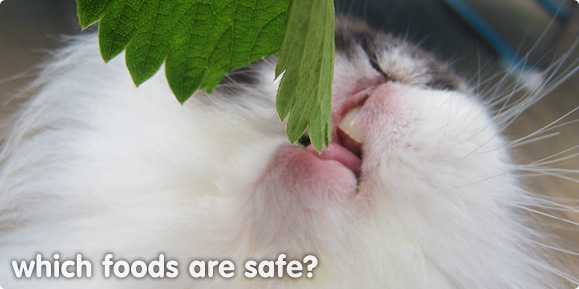
Rabbits love their food and enjoy fresh fruits and vegetables as part of a balanced diet. The main part of a rabbit’s diet should be unlimited amounts of fresh hay (preferably Timothy or Meadow Hay), grass, and plenty of clean water available. See ‘What do rabbits eat?’ for more information.
When introducing any new food, always do so slowly over a few weeks to avoid digestive upsets. Rabbits, like humans are all different and as such some may be unable to tolerate certain foods. Only give a small amount and wait for 24 hours, if your rabbit produces soft poo, withdraw the food and try with something else after everything has settled back to normal. Allow 5 – 7 days before making any other additions. Always wash food first and don’t feed plants from roadsides or that contain pesticides.
The first rule of feeding bunnies and their delicate tummies is: if in doubt – don’t let them eat it! Rabbits have strong tastebuds and will try anything even if it’s poisonous – it’s up to you to protect them! The following list was taken from the RWAF website.
Which vegetables can rabbits eat?
A good guideline is to feed a minimum of 1 cup of vegetables for each 4 lbs of body weight per day.
- Artichoke leaves
- Asparagus
- Baby Sweetcorns (but not full size ones)
- Beetroot (care with leafy tops as high levels of oxalic acid) – can cause gas so limit
- Broccoli (and its leaves, including purple sprouting varieties) – can cause gas so limit
- Brussel Sprouts (leaves and sprouts) – can cause gas so limit
- Cabbage (can sometimes cause digestive upsets) – can cause gas so limit
- Carrots (& carrot tops) – not the roots as they are high in sugars. Carrots should be limited due to high sugar content.
- Cauliflower (and the leaves)
- Celeriac
- Celery leaves
- Chicory
- Courgette (and flowers)
- Cucumber
- Curly Kale
- Fennel
- Green beans
- Kohl rabi
- Peas (including the leaves and pods)
- Peppers (red, green and yellow)
- Pumpkin
- Radish Tops – can cause gas so limit
- Rocket (also known as Arugula)
- Romaine lettuce (not Iceberg or light coloured leaf)
- Spinach (only occasional)
- Spring Greens
- Squash (e.g. Butternut)
- Swede
- Turnip (only occasional)
- Watercress
Which fruits can rabbits eat?
Fruits should be fed in moderation due to sugar content (up to 2 tablespoons worth per day).
Do not feed the pips, stones, plants etc of fruits unless otherwise stated, as most of the time they are poisonous! Rabbits love sugary fruit and will eat too much of it, which is bad for them. Therefore it’s up to you to limit it!
- Apple (not the pips – they are poisonous!)
- Apricot
- Banana (high in potassium)
- Blackberries (and leaves – excellent astringent properties)
- Blueberries
- Cherries (not the pits and plant – they contain cyanide and are therefore poisonous!)
- Grapes
- Kiwi Fruit
- Mango
- Melon
- Nectarines
- Papaya
- Peaches
- Pears
- Pineapple
- Plums
- Raspberries (and leaves – excellent astringent properties)
- Strawberries (and leaves)
- Tomatoes (NOT the leaves)
Safe herbs for bunnies
They can taste very strong so offer a little to start with to get your bunnies used to them.
- Basil
- Coriander (also known as Cilantro
- Dill
- Mint (peppermint)
- Parsley – not too much as high in calcium
- Oregano
- Rosemary
- Sage
- Thyme
Rabbit Diet: What to Feed a Bunny
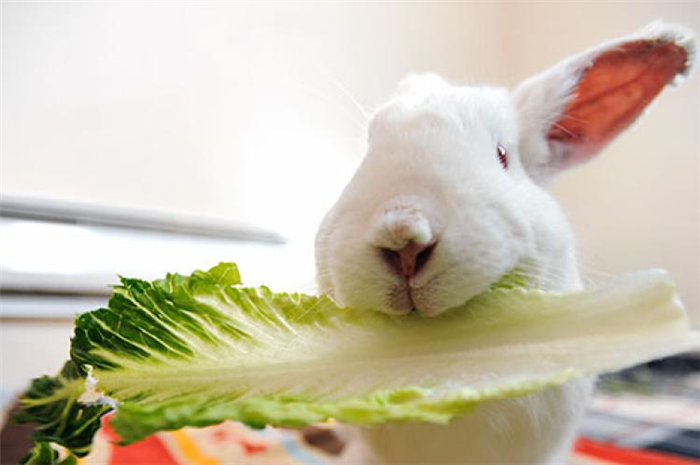
What should pet bunnies eat? Contrary to popular belief, rabbits need to eat more than just carrots and lettuce. They require a balanced diet of hay, fresh veggies and fruit, and a few pellets. Rabbits have very sensitive digestive tracts, so the transition to hay or pellets, or the introduction of new fruits and vegetables, must be done gradually to allow the rabbit’s system to adjust.
Hay: The staple of a rabbit’s diet
The bottom of a rabbit food pyramid would contain long-stemmed fiber, in the form of hay, which makes up 80 to 90 percent of a rabbit’s diet. As grazing animals, rabbits need to have an unlimited supply of fresh hay daily.
You’ll want to feed your rabbit grass hays. Good types of grass hay for bunnies are timothy, orchard grass, brome and oat hay. You can feed your bunnies either one type or a mixture of different grass hays. Buy the freshest hay possible and check for the presence of mold or dust, which could make your rabbit sick.
Alfalfa hay is not a good choice for an adult rabbit, since it’s a legume, not a grass, and as such is too rich to be fed on a daily basis. Alfalfa can be given to rabbits once in awhile as a treat. Rabbits under one year of age can be fed alfalfa hay, but as they get older they should be switched to grass hay, especially if they are also being fed alfalfa pellets.
Pellets: Feed a bunny small quantities
Timothy hay pellets can be given to bunnies in small quantities. An average-sized (6-10 pounds) adult rabbit only needs one-quarter cup of pellets daily. If your rabbit is under five pounds, feed just one-eighth of a cup. Rabbits larger than 10 pounds do not need more than a quarter of a cup, since it’s not a crucial part of a bunny’s diet.
Rabbits under one year old can be fed alfalfa pellets. Be sure to feed grass hay (rather than alfalfa) if you are feeding your young rabbit alfalfa pellets. Look for pellets with a high fiber content — the higher the better. Also, be aware that many foods marketed to rabbits aren’t actually healthy for them and can sometimes be harmful, so please read the ingredients. Do not buy the rabbit pellets that have dried corn, nuts and seeds added, because those foods can potentially be very harmful for rabbits.
Vegetables: A rabbit’s favorite foods
Rabbits count vegetables and herbs among their favorite foods. Most greens found in a supermarket are safe for rabbits, with a few limitations and exceptions. (See the list of foods to avoid below.)
No more than two cups daily of fresh vegetables should be given to adult rabbits. Dwarf breeds and rabbits under five pounds should get just one cup of fresh veggies per day. A variety of two or three vegetables is ideal. Add one new vegetable at a time, and watch for signs of loose stool or diarrhea because, as mentioned above, bunnies have delicate digestive systems. Certain vegetables can be given every day, while others should be fed sparingly, one or two times a week.
Do not feed your rabbit potatoes, corn, beans, seeds or nuts. These foods are difficult for rabbits to digest and can cause serious digestive problems.
Vegetables that can be fed to a rabbit daily:
- Bell peppers
- Bok choy
- Brussels sprouts
- Carrot tops
- Cucumber
- Endive
- Escarole
- Fennel
- Herbs: basil, cilantro, dill, mint, oregano, parsley, rosemary, sage, thyme
- Lettuces: romaine, green leaf, red leaf, Boston bibb, arugula, butter
- Okra leaves
- Radicchio
- Radish tops
- Sprouts: alfalfa, radish, clover
- Watercress
- Wheatgrass
- Zucchini
Vegetables and plants to give sparingly (one or two times a week) to a bunny:
- Broccoli (stems and leaves only)
- Carrots
- Chard
- Clover
- Collard greens
- Dandelion greens (pesticide-free)
- Flowers: calendula, chamomile, daylily, dianthus, English daisy, hibiscus, honeysuckle, marigold, nasturtium, pansy, rose
- Kale
- Spinach
Fruit: Give to a bunny once or twice per week
Fruit should be given to your bunny one or two times a week. The appropriate serving is one to two tablespoons of fruit (either one kind or a mixture) per five pounds of body weight. As with vegetables, fruit should be introduced slowly and one at a time.
Fruit to feed your rabbit (one or two times a week):
- Apple (no seeds)
- Banana
- Berries: blueberries, blackberries, strawberries, raspberries, cranberries
- Cherries (no seeds)
- Grapes
- Melon
- Nectarine
- Orange
- Papaya
- Peach
- Pear
- Pineapple
- Plum
- Watermelon
Treats: Feed to a rabbit sparingly
Like lots of people, many rabbits have a sweet tooth. As with humans, treats are at the top of the food pyramid for bunnies and therefore should be fed sparingly. Healthy treats for your bunny include small pieces of fresh or freeze-dried fruit (the approved fruits listed above); natural, unprocessed mixes that include hay and dried flowers (the approved flowers listed above); and Oxbow brand rabbit treats.
Always read the ingredient list on store-bought treats because not all of them are safe for bunnies. Avoid treats that include added sugar, preservatives and artificial coloring, and never give your rabbit human treats.
Foods to avoid giving a rabbit
Some foods are not good for rabbits under any circumstances because they can make rabbits extremely sick. Here are foods to avoid giving your bunny completely:
- All human treats
- Beans
- Beet greens
- Cabbage
- Cauliflower
- Cereal
- Chocolate
- Corn or corn-cob treats
- Crackers
- Iceberg lettuce
- Legumes
- Mustard greens
- Nuts
- Pasta
- Peas
- Potatoes
- Rhubarb
- Seeds
- Sugar
- Turnip greens
- Yogurt
Fresh water: Unlimited supply for a bunny
Finally, rabbits need to stay hydrated, so they should have an unlimited supply of fresh water, which should be changed daily. The water container should be cleaned with soap and water every few days. Water bottles are not easy to clean and can be difficult for rabbits to use, so bowls are better. A heavy ceramic bowl is ideal, since it doesn’t tip over easily.
About Best Friends Animal Society: A leader in the no-kill movement, Best Friends runs the nation’s largest no-kill sanctuary for companion animals, as well as lifesaving programs in collaboration with thousands of partners nationwide working to Save Them All.
What Do Bunnies Eat?
“Bunny” is a nickname given to the young rabbits. But did you know that bunnies eat different foods than adult rabbits? In fact, just like other young animals, bunnies eat according to their unique needs during their early stages of life. The foods bunnies eat must support their overall health and wellness in addition to helping their bodies develop for adulthood. Their diet from birth to the time they are fully grown also helps them develop good eating habits for the rest of their adult lives.
Before diving into what bunnies eat, it is important to know more about these soft, cute, and small mammals. First, did you know that there are many species of bunnies? In fact, there are 29 species in 10 genera that live on all of the continents except Antarctica.
17 bunny species are cottontails found in North America and South America. Of the 29 species in the world, the American Rabbit Breeders Association (ARBA) recognizes 49 breeds. These are domesticated bunnies bred for their distinct traits like physical characteristics, health, demeanor, and size. Most of these reach weights of between 2.5lbs to 16lbs in adulthood. But some, like the French Lop and Angora, can get bigger.
What Do Bunnies Eat?
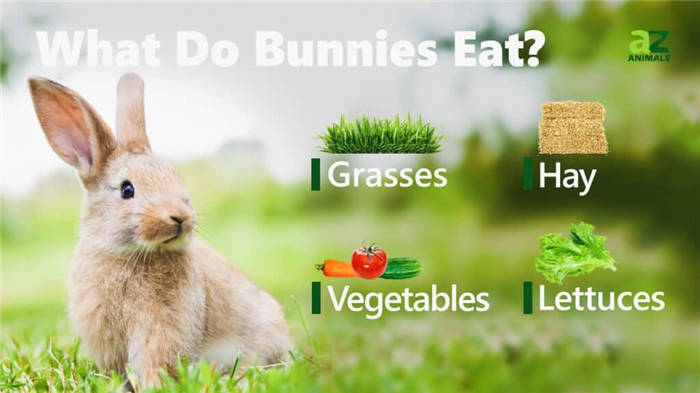
Bunnies eat grasses, hay, vegetable, and lettuces.
As herbivores, bunny rabbits are continuous grazers that spend most of each day eating ground-level and low-lying vegetation. Bunnies eat a very specific diet, though. Their health depends on not making quick changes to their foods. If bunnies eat foods they are not used to, this disrupts their digestive flora balance and can cause them to suffer gas, toxicity, sickness, and even death.
Rabbits start their lives on a diet of their mother’s milk, surprisingly taking in milk only once or twice for a total of five minutes per day. They keep nursing like this until they wean at 6 weeks to 8 weeks old. Baby bunnies add their first solid food at about 2 weeks to 3 weeks of age. These first solids usually consist of their nest hay. Then, by week 3 to week 4 of life, the bunnies eat the same foods as their mother, along with nursing her milk. Because they go through so many diet changes in these early weeks around weaning, a bunny’s digestive system is very sensitive during this time. This makes it very important for young bunnies to stay with their mother, follow her lead, and nurse until they are of weaning age.
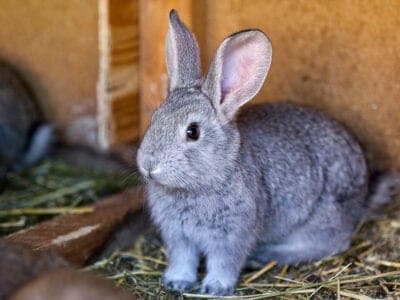
Keeping A Pet Rabbit: Read BEFORE Buying
The typical rabbit diet after weaning is grass from grazing all day. They also eat various kinds of hay. Only baby bunnies can eat alfalfa hay, however. Adult rabbits should not consume alfalfa because it contains too much protein and calcium that fully grown species do not need.
After weaning, rabbits of all ages also enjoy fresh fruit and vegetables. But feeding a bunny or rabbit too many vegetables can hurt their stomach. This is contrary to what most people believe about bunnies and rabbits enjoying a diet of mostly carrots and lettuce. They should take these foods in as treats in limited amounts and on top of a healthy diet.
Baby bunnies and fully grown rabbits in the wild eat by grazing. This is their main activity each day, from waking to sleeping. Domesticated rabbits are raised for their meat or fur and pet rabbits eat when fed by their human owners. All species of rabbits around the world eat the same basic diets of grasses and hay after weaning from their mother. The type of hay varies according to geography and availability.
What Do Bunnies Eat in Captivity vs in the Wild?
What bunnies eat in captivity differs from what they eat in the wild. Wild bunnies eat grass by grazing all day from 2 weeks of age. They continue this grazing after weaning from their mother’s milk. But domestic rabbits kept without their mothers under the age of 8 weeks need their human owners to provide them with milk formula provided by a veterinarian. This milk is a close match to the mother’s own.
From 2 weeks of age, it is also important that domestic baby bunnies eat nutritional hay pellets made specifically for rabbits. They need these along with an ongoing supply of alfalfa hay to accompany their mother’s milk or substitute formula. From 8 weeks of age, baby bunnies can eat some garden vegetables in very limited amounts.
Captive bunnies on farms or raised as pets are often overfed. This can lead to digestive problems, health problems, and weight conditions. One of the most common problems with the diets of rabbit pets is overfeeding of vegetables like lettuce and carrots. Adult rabbits are also often mistakenly fed alfalfa hay that contains too much protein and calcium for fully-grown animals. The adult rabbits eat fewer hay pellets than babies and may stop needing them altogether.
You may notice wild rabbits in the garden of your home from time to time. They enjoy snacking on vegetables when they are available to them. While it is unhealthy to feed rabbits kept as pets too many of some kinds of vegetables, wild rabbits eat only what they need. They will go back to munching on grass once they have had enough of the bounty in the garden.
A Complete List of 33 Foods Bunnies Eat
As herbivores, bunnies eat a combined diet of grasses, hay, and their mother’s milk. After they wean from milk, they live exclusively on vegetation found in the garden or in the wild and freshwater. In fact, hay makes up 80% to 90% of a rabbit’s daily diet. Ideally, this provides the fully grown rabbit with a diet of 40% fiber, 10% to 12% protein, and other nutrients.
Bunnies eat a daily diet that safely includes these 25 primary foods:
- Grasses
- Wheatgrass
- Bermuda grass
- Orchard grass
- Alfalfa grass (as a baby only)
- Oats
- Hay
- Hay pellets
- Vegetables they nibble on in the garden
- Bell peppers
- Sprouts (alfalfa, radish and clover)
- Bok choy
- Watercress
- Carrot tops
- Zucchini
- Endive
- Radish tops
- Escarole
- Brussels sprouts
- Fennel
- Lettuces
- Okra leaves
- Cucumber
- Radicchio
- Herbs
Rabbits eat fruit in limited amounts once or twice per week without any digestive problems.
Eight other foods a rabbit eats only once or twice per week as a treat include:
- Carrots
- Collard greens
- Broccoli (only stems and leaves)
- Chard
- Clover
- Dandelion greens (pesticide-free)
- Spinach
- Kale
Dried corn, nuts, and seeds are foods a rabbit should not eat, along with any foods made specifically for humans to eat.
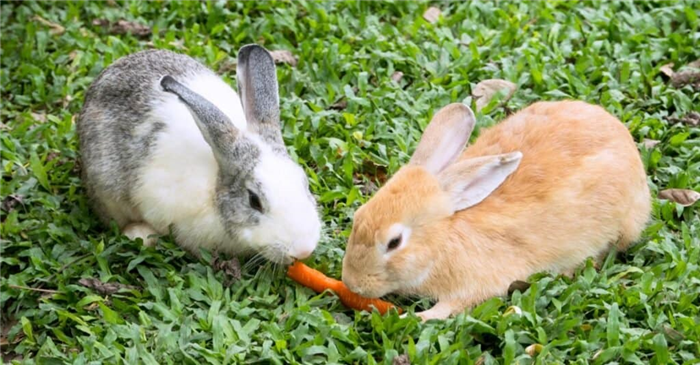
Two small rabbits in the grass, sharing a piece of carrot.
Thor Jorgen Udvang/Shutterstock.com
What Predators Eat Bunnies?
Although rabbits eat only plant matter and are therefore herbivores, they are a favorite meal for many predators. The predators that eat bunnies include:
Opossums will sometimes kill rabbits without eating them.
Share this post on:
AZ Animals Staff
AZ Animals is a growing team of animals experts, researchers, farmers, conservationists, writers, editors, and — of course — pet owners who have come together to help you better understand the animal kingdom and how we interact.
What Do Baby Rabbits Eat?
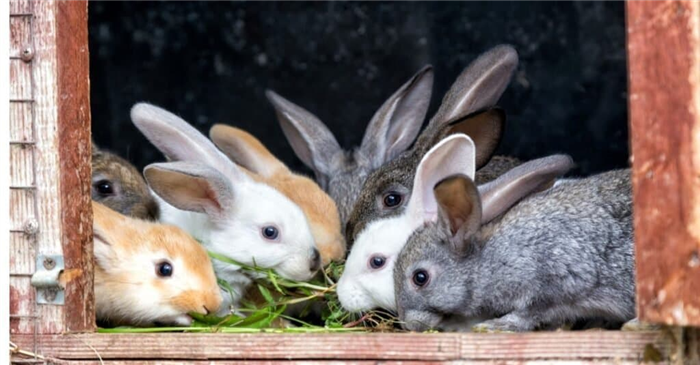
Baby rabbits will live off of their mother’s milk for the first 3 to 4 weeks of life.
Baby rabbits, also known as kits or kittens, are born underdeveloped. They have no fur, and can not open their eyes. As such, baby rabbits are completely dependent on their mother or caretaker for nutrition. On average, kits will nurse for the first three to four weeks of life. Rabbit milk is very calorie-dense and delivers all the nutrients that baby rabbits need to thrive. Once they’re old enough, kits will begin to venture out and forage like adult rabbits. At this time, their diet is about the same as an adult rabbit. Pet or rescued baby rabbits separated from their mother should be fed goat milk or a specialty rabbit milk replacement. Baby rabbits cannot drink cow’s milk, and should never be fed it under any circumstances. Before introducing new food to a baby rabbit, make sure to consult with your veterinarian.
